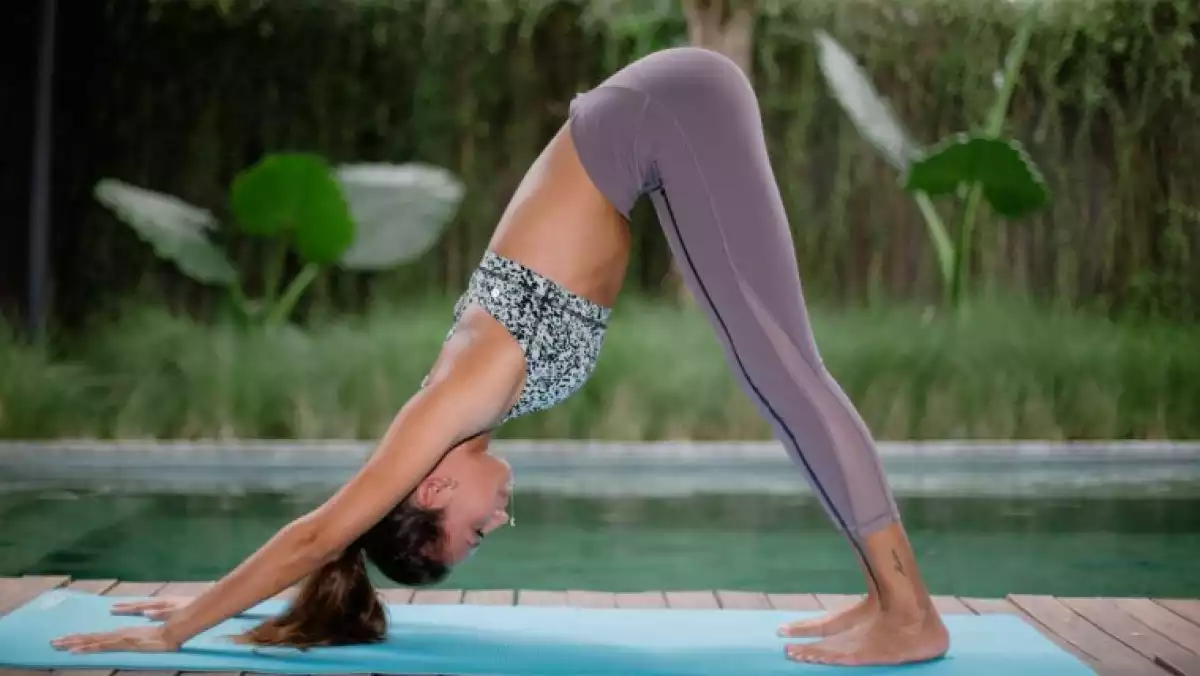
When stress and anxiety invade your life, relaxation techniques are great allies when it comes to relieving stress and tension. Also, these will help you to pinpoint the problems that are interfering with your life the most and impeding your peace and well-being, both on a physical and psychological level.
In the following article, we'll tell you how to relax your mind using the most effective relaxation techniques that we know about today like Jacobson's progressive muscle relaxation or mindfulness meditation. Besides, we'll tell you who can get the most out of each relaxation technique and explain the factors that cause stress.
How to relax your mind using relaxation techniques
When someone is going through a stressful time in their life that generates anxiety, the body usually reacts by going into the fight or flight response mode, putting this person in a constant state of alert. Because of this, getting mental rest becomes almost impossible, and as a result, intellectual performance falls exponentially.
Besides, this anxious state tends to bring up negative feelings and emotions that when added to fatigue, accentuate the problem, even more, making it hard to find the right solution to the predicament.
In these circumstances, we can particularly benefit from the use of relaxation methods that help to improve rest, well-being, and therefore, quality of life.
Stress is the mechanism that the body uses to adapt to new situations. According to Selye (1936), this is a natural adaptive response in which the autonomic nervous system and the hypothalamic-pituitary-adrenal axis activate. The problems happen when this stressful situation isn't resolved and persists for an extended period.
In this case, physiological activation is such that proper rest isn't possible. This can come from a wide variety of disorders related to anxiety, a lack of attention, or memory deficits. These feelings of uneasiness or difficulty concentrating can be counteracted using relaxation techniques to relax your mind.
Related: Relaxing Music: 25 Songs For You To Relax
How do relaxation techniques work?
Do you want to know how to relax your mind? Relaxation techniques work to encourage rest and relieve tension that both the body and the mind store due to situations that cause stress and anxiety, whether they are just passing or something chronic. These methods fight to reduce the body's general level of activation using different methods.
The methods that have shown truly effective results through systematized studies were created at the beginning of the century and continue to be used in the present day -this holds particularly true for Jacobson's progressive muscle relaxation (PMR) and Schultz's autogenic training method (1931).
These two relaxing activities, along with traditional eastern relaxation techniques (yoga, mindfulness, or transcendental meditation), make up the vast array of possibilities that people that want to find ways to relax can choose from if they want to feel more comfortable and get better results.
How to relax your mind: the 5 best ways
As we mentioned, Jacobson's progressive muscle relaxation (PMR) and Schultz's autogenic training method have proven to be the most effective ways to relax. However, many other relaxation techniques use these as a point of reference, and they are also highly successful.
On top of the previously mentioned ones, below, we'll give you a summary of the methods that have their origins in Buddhism and eastern cultures, that focus on the sense of relaxation that meditation brings.
Related: Mandala: Meaning And 5 Simple Coloring Pages

1. Deep breathing exercises
Deep breathing exercises are at the base of most relaxation techniques to relax your mind. This type of breathing helps oxygen to reach all corners of the body sufficiently, reducing their activity, and thus relieving anxiety.
To perform this kind of breathing, you just need to follow these steps:
Sit up tall in a comfortable place. Release all of the air in your lungs and, with one hand on your chest and the other on your abdomen, breathe deeply.
To make this diaphragmatic breathing, try to send the air that you inhale to your abdomen, taking note of how the hand in this region rises slightly, while the hand on your chest remains still.
Hold in this air for a few seconds until you feel the need to exhale. Do this slowly, emptying the abdomen and exploring how the air exits through your mouth. Once your lungs are empty, hold this exhale for a few seconds and then take another deep breath, pushing the air towards your stomach. Repeat this cycle for 5 minutes.
2. Jacobson's progressive muscle relaxation
This relaxation technique focuses on physical relaxation over the mental kind. However, its effects also help on a psychological level due to the interconnectedness of these systems. This method consists of working through all of the muscle groups and relaxing them progressively.
During the first weeks of training, you should set aside more time for relaxation -approximately 30 or 40 minutes. As you gain the appropriate skills, it will take you less time. Here's how to relax your mind and body with progressive muscle relaxation:
Sit or lie down in a peaceful, comfortable place, free of distractions. Close your eyes and let your body rest in a natural position. If you are lying down, you should do so on your back, and if you are sitting, place the palms of your hands on your thighs. Now, breath deeply, just as we explained in the previous section on deep breathing exercises.
Focus on your dominant hand, clench your fist and contract your forearm muscles, keeping this tension for a few seconds and flex them -notice how they relax. Do the same with the other hand and the biceps following this order: dominant hand, biceps, non-dominant hand, biceps.
Now, move onto relaxing the facial muscles, contracting the forehead and releasing; do the same with the jaw, face, and neck. Remember to focus on the feeling of relaxation when releasing the tension in these muscles. Leave 20 seconds of space between one muscle and the next.
After, you need to follow the same procedure with the region of your body starting with your abdomen and ending with your legs, starting by contracting and releasing the muscles, beginning with the calves and ending with the feet. It's crucial that you always follow the same order which can either be ascending or descending.
3. Schultz's autogenic training method
Schultz's autogenic training method is based on the self-hypnosis or autosuggestion of the individual through mindful concentration on the feelings that come up in the body while carrying out a series of activities.
Although it's based on Jacobson's progressive muscle relaxation, this technique resembles meditation more closely since it's more complex than the method prior, and requires more training time, but, in the long-term, it's more effective.
Autogenic training consists of six exercises focused on physical sensations: heaviness, warmth, the heartbeat, breathing, abdominal sensations, and the mind. These six exercises have to be learned and performed in the order that we've stated. Meaning that once you've mastered the heaviness exercise, you can move onto heat, and so on.
Related: Hypnosis: Reality Or Myth? Main Uses And Techniques

4. Yoga
Besides being an activity to achieve a sense of spiritual fulfillment and improving body posture, yoga is also considered a relaxation technique since it improves breathing and relieves muscle tension. Plus, it helps to protect the person who practices it in a certain way from the stresses of the fast-paced life that is so common in western societies.
There is one specific relaxation technique in yoga called Sukshma that works to achieve physical relaxation in just 7 minutes. You can do this anywhere without any formal training since its one of the simplest practices out there.
First of all, you need to focus on your skull: put your hands on your head, right above your ears, and massage the temples in a circular motion. This will help you to relax instantaneously.
Now, focus on your eyes. Move them in a clockwise rotating motion six times, and then repeat the same activity in the opposite direction. This helps you to rest your eyes and fights headaches brought on by stress. Closing your eyes hard and open them quickly can also help.
The ears are one of the areas of the body that have the most nerve endings which is why massaging your ear lobes gives you a pleasant feeling that can help you to calm down; this is a practical and straightforward relaxation technique if you want to relax your mind.
The jaw is another tense area that causes a lot of anxiety and stress. So, open your mouth and with the help of your fingers try massaging the region starting with the cheekbones down until your chin. Repeat this several times to release the tension of the muscles in this area.
Related: Couples Yoga: Benefits And Poses For Two
5. Mindfulness
In the present day, mindfulness is one of the most successful relaxing activities out there. Eastern cultures and medicine, and Buddhists, in particular, take center stage when it comes to those that opt for alternative options to de stress when compared to Western therapies.
These relaxation techniques help to reconnect with oneself by being fully aware at all times. In mindfulness, it's important to be conscious of everything that you put in your body, including both physiological and emotional sensations.
There are different methods to reach a state of total awareness, and as a result, full mental and physical relaxation. So, here's how to relax your mind via mindfulness.
One relaxation exercise is called "one minute of full attention." Here you have to focus all of your attention on breathing for one full minute. This should be diaphragmatic breathing and your mind shouldn't be wandering here either, instead, you should be 100% focused on the internal sensations that come up while you're breathing.
The "body scan" is another meditation exercise that brings a feeling of calmness and inner peace. The goal of this relaxing activity is to focus on what you feel in each of the main areas of the body. This way, you can come into direct contact with the body in the most objective way possible.
Check out the original article: Las 5 técnicas de relajación más eficaces para combatir el estrés at viviendolasalud.com
References
Jacobson, E. (1938). Progressive relaxation. Chicago: University of Chicago Press.
Schultz, J. H. (1932). Das Autogene Training. Thieme: Leipzig.
Selye, H. (1936). A syndrome produced by diverse nocuous agents. Nature, 138(3479): 32.
